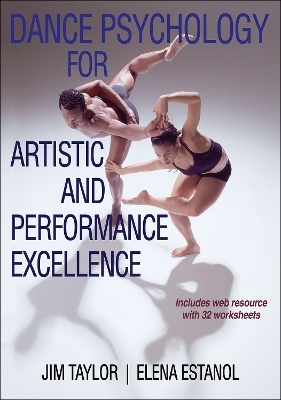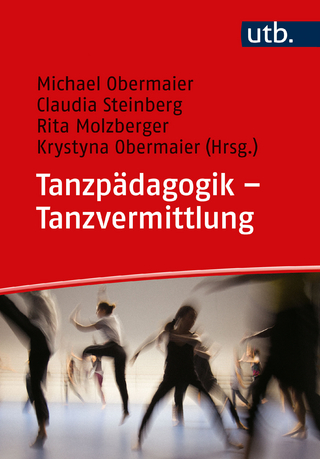
Dance Psychology for Artistic and Performance Excellence
Human Kinetics (Verlag)
978-1-4504-3021-0 (ISBN)
The dance world is filled with technique books, which certainly serve an important role in helping dancers improve their performance. But the market has been conspicuously void of instruction on a vital aspect of dance performance: the mental aspect.
Developing Psychological Strength in All Dancers
Jim Taylor, a veteran sport and dance psychologist and author, and Elena Estanol, a dancer, instructor, and sport and dance psychologist, bring their experience and knowledge to Dance Psychology for Artistic and Performance Excellence to help dancers at all levels develop psychological strength to maximize their performance.
Dance Psychology for Artistic and Performance Excellence will help dancers in these ways:
• Understand how to use the mental aspects of dance to their advantage.
• Learn simple techniques to raise their dancing to a new level.
• Refine their technique and overcome performance challenges.
Individualized Program and Web Resource Tools
Dancers will build a strong foundation for performance by employing the dance-specific psychological strategies. The individualized program will help dancers reach their potential in artistry and excellence in school, the dance profession, and dance-related careers. The book comes with a companion web resource containing 40 worksheets that will help dancers grow mentally through reflection and self-examination. Dancers will be able to use these tools to refine their technique and overcome performance challenges.
Scientifically Proven Psychological Methods
Dance Psychology for Artistic and Performance Excellence incorporates some updated content from Taylor’s original best-selling book Psychology of Dance. Through the authors’ research and experience with dancers over the past two decades, this book offers the latest in scientifically proven psychological methods and practices that dancers have used to achieve optimal performance. As the authors write in their preface:
What separates good dancers from the best dancers lies in how mentally prepared they are to perform their best, despite circumstances that dance and life throw at them. Dancers who are the most motivated to train, who have the greatest confidence in themselves, who perform best under pressure, who stay focused on their performance, who keep their emotions under control, and who are able to direct their emotions to elevate their performance and technique to true artistry are the most successful and revered.
Key Psychological Concepts Explored
To help dancers elevate their performance, the authors explore these concepts in the context of dance performance and provide practical exercises for each concept:
• Self-knowledge
• Motivation
• Confidence
• Intensity
• Focus
• Emotions
• Goal setting
• Imagery
The authors also examine the foundations of dance psychology and delve into special concerns for dancers, including stress and burnout, pain and injury, and disordered eating.
Making Your Mind the Most Powerful Tool
Once you get to a certain level, your mind is your most powerful tool—or your most harmful weapon. Dance Psychology for Artistic and Performance Excellence will help dancers turn their minds into powerful tools not only to improve their technical and artistic performance but also to enhance their enjoyment, bring greater fulfillment, and enrich their lives personally and professionally. This text is an important contribution to the Human Kinetics dance list because it equips dancers with the psychological tools they need for success.
Jim Taylor, PhD, is a long-time sport psychologist and a consultant, speaker, and author who has worked with dancers for three decades. He is also a coauthor of Psychology of Dance, a predecessor of this book, and has consulted with Miami City Ballet. He is a member of the American Psychological Association and the Association for Applied Sport Psychology. Taylor received a PhD in psychology from the University of Colorado at Boulder. He enjoys skiing, running, and cycling. Elena Estanol, PhD, MFA, is a counseling sport psychologist, speaker, peak performance, wellness, and ADHD coach and executive director of Synapse Counseling, LLC, a wellness center that provides cutting-edge sport psychology services, eating disorder and ADHD treatment to dancers, athletes, and performing artists in Fort Collins, CO. She has spent most of her life dancing, teaching, and choreographing dance. She is a frequent consultant to dance schools, companies, and teams. Estanol is a member of the American Psychological Association, the Association for Applied Sport Psychology, and the International Association for Dance Medicine and Science. She received her PhD in counseling psychology, MS in sport psychology, and MFA in kinesiology, choreography, and pedagogy from the University of Utah. In her leisure time, she enjoys hiking, yoga, dancing, writing, and aerial silks (aerial dance).
Part I Building a Foundation
Chapter 1 Foundations of Dance Psychology
Chapter 2 Self-Knowledge
Part II Prime Dance Pyramid
Chapter 3 Motivation
Chapter 4 Confidence
Chapter 5 Intensity
Chapter 6 Focus
Chapter 7 Emotions
Part III Prime Dance Tools
Chapter 8 Goal Setting
Chapter 9 Imagery
Chapter 10 Routines
Chapter 11 Individualized Program
Part IV Special Concerns for Dancers
Chapter 12 Stress and Burnout
Chapter 13 Pain and Injury
Chapter 14 Disordered Eating
Chapter 15 Dance for Your Life
| Verlagsort | Champaign, IL |
|---|---|
| Sprache | englisch |
| Maße | 178 x 254 mm |
| Gewicht | 658 g |
| Themenwelt | Kunst / Musik / Theater ► Theater / Ballett |
| Sachbuch/Ratgeber ► Sport ► Tanzen / Tanzsport | |
| ISBN-10 | 1-4504-3021-X / 145043021X |
| ISBN-13 | 978-1-4504-3021-0 / 9781450430210 |
| Zustand | Neuware |
| Haben Sie eine Frage zum Produkt? |
aus dem Bereich


